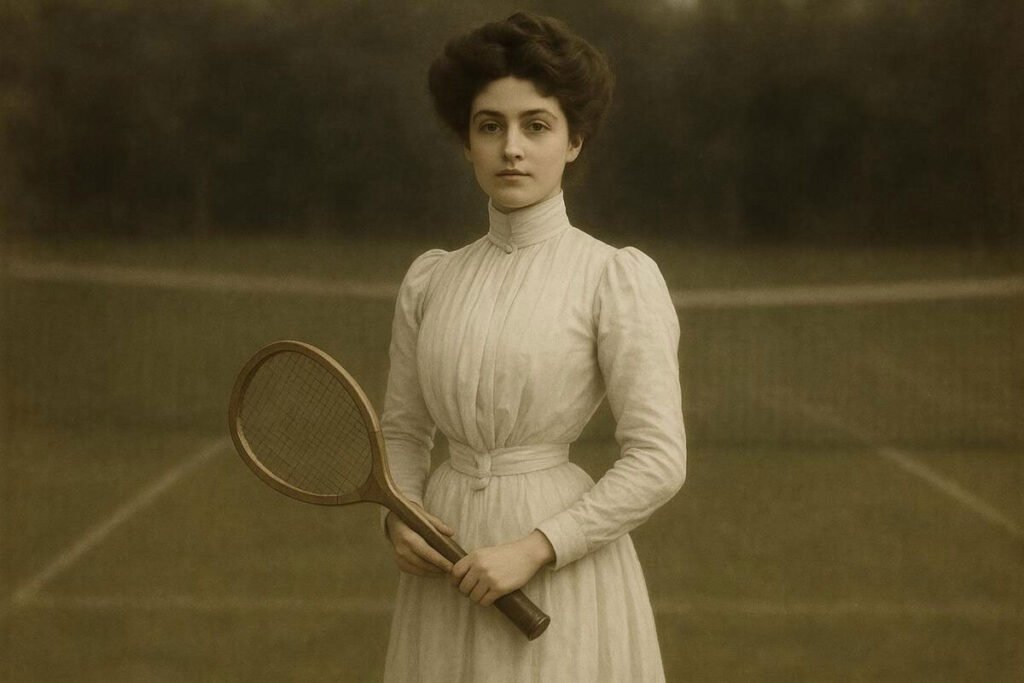
A Precocious Talent from New Jersey
In the annals of American sports, some names resonate with a pioneering spirit that transcends their era. Elisabeth “Bessie” Holmes Moore, born in Brooklyn, New York, on March 5, 1876, is one such name. Raised in the affluent community of Ridgewood, New Jersey, she was the daughter of a wealthy cotton broker, George Moore, and his young wife, Sarah. Encouraged by her mother to lead an active life, Moore embraced sports with a natural enthusiasm that would soon find its focus on the tennis court.
Her journey into tennis began at the age of 12 at the Hohokus Valley Tennis Club, where her father served as president. It was on these courts that she discovered a profound connection to the game, quickly developing a passion that would define her legacy. Her early years were marked by a quiet determination and a level of skill that clearly set her apart from her peers.
The Rise of a Champion
At the tender age of 16, Moore burst onto the national scene in 1892 at the U.S. National Championships in Philadelphia. Affectionately dubbed the “little girl from New Jersey,” she stunned spectators by strategically dismantling several experienced players to reach the final. Though she ultimately fell to the defending champion, Mabel Cahill, in a grueling five-set match, her performance was a powerful statement announcing the arrival of a new force in women’s tennis.
This early success was merely a prelude. Moore’s rivalry with fellow New Jersey native Juliette Atkinson became a defining narrative of late 19th-century tennis. In 1896, she captured her first U.S. National Championship singles title by defeating Atkinson, a victory that marked the beginning of a years-long battle for supremacy that pushed both players to greater heights.
A Unique and Strategic Playing Style
Moore’s game was not built on speed or raw power. Instead, she cultivated a unique and cerebral playing style that relied on intelligence, precision, and an uncanny ability to anticipate her opponent’s moves. This allowed her to cover the court with a quiet efficiency that often left her more athletic opponents bewildered. She was a master of the long rally, patiently wearing down her adversaries with unwavering consistency.
One of her most remarkable and talked-about attributes was her ambidextrous ability. Her forehand and backhand strokes were so similar that they were nearly indistinguishable. She was even known to switch the racquet to her left hand to retrieve shots that seemed out of reach. This versatility, combined with her pinpoint accuracy, made her a formidable opponent for even the most aggressive net-rushers of her time.
Dominance and Historic Achievements
Throughout her illustrious career, Elisabeth Moore amassed a remarkable collection of titles. She claimed the U.S. National Championships singles crown four times—in 1896, 1901, 1903, and 1905. Her eight appearances in the singles final stood as a record for many years, a powerful testament to her enduring talent and consistent excellence at the highest level of the sport.
In 1901, Moore etched her name in the history books by playing two consecutive five-set matches, a feat of physical and mental endurance that remains unparalleled in women’s tennis. She also won the inaugural U.S. Indoor Women’s Singles Championship in 1907 and the indoor doubles title in 1908, further cementing her status as a dominant and versatile force in American tennis.
A Trailblazer for Women in Tennis
Beyond her impressive collection of trophies, Moore was a true pioneer who helped shape the future of women’s tennis. In 1898, she broke new ground by becoming the first prominent American female tennis player to compete overseas, traveling to Dublin for the Irish Championships. This courageous step helped to open the door for future generations of American women to test their skills on the international stage.
Moore was also a fierce advocate for her fellow female players. When the male-dominated United States National Lawn Tennis Association decided to shorten women’s championship matches from five sets to three, she was among the most outspoken critics. She passionately argued that tennis was a game of endurance as well as skill, and that the voices of the women who played the game should be heard.
Later Years and Lasting Legacy
Even as she entered her later years, Moore’s competitive fire did not fade. She remained a formidable presence in the sport, particularly in doubles, and continued to win tournaments into her early 40s. Although the breathing difficulties she battled for much of her life eventually forced her to step away from top-level competition, her love for the game never waned. After her playing days, she lived in New York and Florida.
Elisabeth Moore passed away on January 22, 1959, at the age of 82, leaving behind a legacy that is both rich and enduring. In 1971, she was posthumously inducted into the International Tennis Hall of Fame, a fitting tribute to a champion who not only dominated her era but also helped to build the foundation for the future of women’s tennis. Her story continues to inspire, a timeless reminder of the power of skill, strategy, and an unbreakable pioneering spirit.

